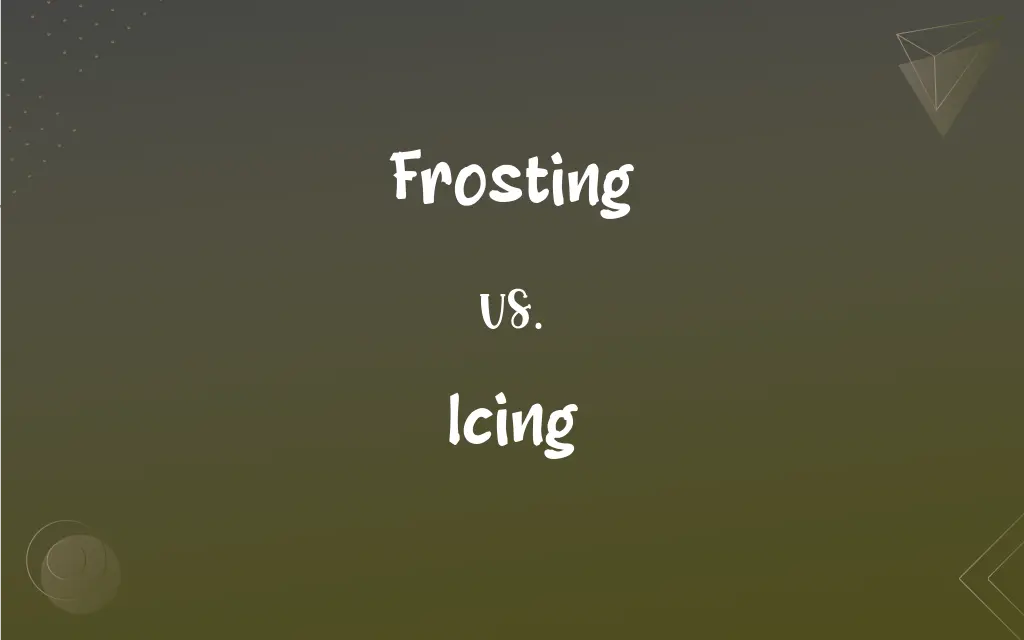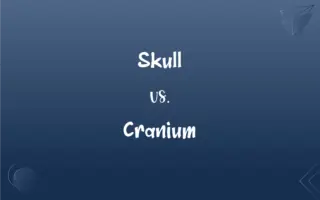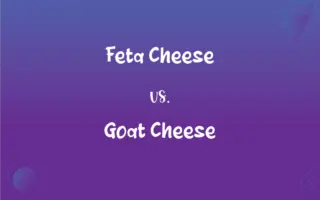Frosting vs. Icing: What's the Difference?
Edited by Aimie Carlson || By Harlon Moss || Updated on October 23, 2023
Frosting is a thick, fluffy coating for cakes, while icing is a thinner, often glossy, glaze for pastries and cakes.

Key Differences
Frosting refers to a creamy, buttery mixture that's typically spread over cakes or cupcakes. It's often rich in flavor, offering a soft texture that contrasts with the cake's crumb. Icing, on the other hand, is a sugary glaze that can be drizzled or spread over pastries, cakes, cookies, and more, providing a shiny finish.
The main difference between frosting and icing lies in their texture and consistency. Frosting is denser, creamier, and can hold shapes (like those made from a piping bag), making it ideal for detailed decorations. Icing is usually more fluid, setting up harder, and is often used to give a glossy look or a thin layer of sweetness to baked goods.
In terms of ingredients, frosting typically contains butter, sugar, and often some form of liquid (like milk or cream) and flavorings. It's whipped to a fluffy consistency. Icing, however, is predominantly a mix of powdered sugar and a liquid (like milk or water) and is generally smoother and more liquidy than frosting.
In culinary applications, frosting is commonly used to cover the entirety of a cake or to add decorative touches like rosettes or borders. Icing might be drizzled over pastries or used to write on cakes, and it hardens as it dries. Both, however, add flavor, texture, and visual appeal to baked goods.
Comparison Chart
Consistency
Thick and creamy
Thinner and often glossy
ADVERTISEMENT
Common Ingredients
Butter, sugar, milk/cream, flavorings
Powdered sugar, milk/water
Usage
Covers or decorates cakes
Glazes pastries or writes on cakes
Texture when set
Remains soft
Can harden
Ability to hold shapes
Can hold shapes (e.g., from a piping bag)
Usually too thin for detailed shapes
Frosting and Icing Definitions
Frosting
A creamy, butter-based spread used to cover or decorate cakes.
The chocolate frosting on the cake was rich and velvety.
ADVERTISEMENT
Icing
A sweet component that can be thin or slightly thicker in consistency.
The cinnamon rolls had a generous drizzle of vanilla icing.
Frosting
A culinary component that contrasts with the texture of cakes.
The soft frosting complemented the dense texture of the brownies.
Icing
A mixture primarily of powdered sugar and liquid that dries glossy.
The icing on the sugar cookies hardened into a shiny finish.
Frosting
A sweet layer added to enhance the flavor and appearance of baked goods.
The carrot cake had a generous layer of cream cheese frosting.
Icing
A confectionery addition often used for its aesthetic appeal.
The gingerbread house was adorned with colorful icing decorations.
Frosting
A thick mixture that can hold detailed shapes when piped.
She used vanilla frosting to create rosettes on the cupcakes.
Icing
A decorative element that can be tinted and used for detailing.
She wrote Happy Birthday with pink icing on the cake.
Frosting
A topping that can be flavored in various ways, from vanilla to mocha.
The lemon frosting added a tangy twist to the dessert.
Icing
A sugary glaze drizzled or spread over pastries, cakes, or cookies.
The donuts had a thin layer of icing on top.
Frosting
Icing, as on a cake.
Icing
A sweet glaze made of sugar, a liquid such as milk or water, and often other ingredients, spread over the surface of baked goods for flavor or decoration. See Note at frosting.
FAQs
Is frosting used for detailed cake decorations?
Yes, due to its thick consistency, frosting can hold detailed shapes.
Does frosting always contain butter?
Most traditional frostings contain butter, but there are non-butter-based variations.
What is the primary ingredient in icing?
The primary ingredient in most icings is powdered sugar.
Can I refrigerate leftover frosting and icing?
Yes, but it's advisable to let them come to room temperature before using them again.
Why does icing sometimes appear translucent?
Due to its thin consistency and sugar content, icing can appear slightly translucent when spread thinly.
Is icing more liquid than frosting?
Generally, yes. Icing tends to be more fluid than frosting.
Is buttercream a type of frosting?
Yes, buttercream is a popular type of frosting made with butter and powdered sugar.
Why do some recipes call for both frosting and icing?
Frosting provides a thick base or decoration, while icing might add a glossy finish or extra detailing.
Is royal icing a type of icing that hardens?
Yes, royal icing dries hard and is often used for detailed decorations.
Why did my icing turn out lumpy?
Lumps in icing can result from undissolved sugar or other ingredients.
Can I add fruits or chocolate to my frosting?
Absolutely, fruits, chocolate, and other mix-ins can be added for flavor and texture.
Can I flavor my frosting with different extracts?
Absolutely, frosting can be flavored using various extracts like vanilla, almond, or mint.
Can frosting be used as a cake filling?
Yes, many cakes use frosting both as a coating and a filling.
Is it possible to over-whip frosting?
Yes, over-whipping can make frosting too airy or cause it to separate.
Are frosting and icing the same thing?
No, frosting is thicker and creamier, while icing is thinner and often glossy.
Can I use frosting and icing interchangeably in recipes?
While they're similar, their different consistencies mean they're best suited for specific uses.
Can icing harden over time?
Yes, many icings can harden when they dry.
Can I add color to my frosting and icing?
Yes, both frosting and icing can be tinted using food coloring.
What tools are used to apply frosting?
Spatulas and piping bags are common tools for applying frosting.
Can I make icing without powdered sugar?
While powdered sugar is a primary ingredient, there are alternative recipes using other sugar types.
About Author
Written by
Harlon MossHarlon is a seasoned quality moderator and accomplished content writer for Difference Wiki. An alumnus of the prestigious University of California, he earned his degree in Computer Science. Leveraging his academic background, Harlon brings a meticulous and informed perspective to his work, ensuring content accuracy and excellence.
Edited by
Aimie CarlsonAimie Carlson, holding a master's degree in English literature, is a fervent English language enthusiast. She lends her writing talents to Difference Wiki, a prominent website that specializes in comparisons, offering readers insightful analyses that both captivate and inform.































































